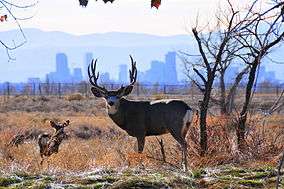Involuntary park

Involuntary park is a neologism coined by science fiction author and environmentalist Bruce Sterling to describe previously inhabited areas that for environmental, economic, or political reasons have, in Sterling's words, "lost their value for technological instrumentalism" and been allowed to return to an overgrown, feral state.
Origin of the term
Discussing involuntary parks in the context of rising sea levels due to global warming, Sterling writes:
They bear some small resemblance to the twentieth century's national parks, those government-owned areas nervously guarded by well-indoctrinated forest rangers in formal charge of Our Natural Heritage©. They are, for instance, very green, and probably full of wild animals. But the species mix is no longer natural. They are mostly fast-growing weeds, a cosmopolitan jungle of kudzu and bamboo, with, perhaps, many genetically altered species that can deal with seeping saltwater. Drowned cities that cannot be demolished for scrap will vanish wholesale into the unnatural overgrowth.[1]
While Sterling's original vision of an involuntary park was of places abandoned due to collapse of economy or rising sea-level, the term has come to be used on any land where human inhabitation or use for one reason or other has been stopped, including military exclusion zones, minefields and areas considered dangerous due to pollution.[2][3][4]
Real involuntary parks
Real examples do indeed fulfil the description of "green" and "full of wild animals", but Sterling's dystopian vision of an "unnatural" ecology has not been observed. Rather, the Chernobyl disaster area has seen the return of long-gone natural animals such as boars, wolves, bears, and a thriving herd of released Przewalski's Horses.[5] While wildlife flourishes in the least affected areas, tumors, infertility and lower brain weight is reported from many smaller animals in the more contaminated areas.[6] The former Rocky Mountain Arsenal, Denver, CO was abandoned for years due to contamination from production of chemical weapons, yet the wildlife returned and the site was eventually turned into a wildlife refugium.[7]
Involuntary parks where human presence is severely limited can host animal species that are otherwise extremely threatened in their range. The Korean Demilitarized Zone is thought to house not only Korean tigers, but also the critically endangered Amur leopard.[8]
Examples
- The Cattle island in the flood pond of Hirakud Dam
- The Green Line in Cyprus.
- The Korean Demilitarized Zone.
- The zone of alienation around the area of the Chernobyl disaster, notably the Red Forest.
- The Frontier Closed Area in Hong Kong.
- The White Sands Missile Range U.S. government military reservation. Location of the Trinity test site.
- The stringent military control of the Iron Curtain has left a large green corridor across Europe. An initiative is underway to protect this former involuntary wilderness as a European Green Belt.
- The waterfront of Hilo, Hawaii was stricken by two devastating tsunami, and the strip was abandoned and made into parkland.
- The land formerly occupied by a residential area in Anchorage, Alaska was cracked and disfigured beyond usefulness by the Good Friday earthquake, and was converted into a park named Earthquake Park.
- The former Rocky Mountain Arsenal and the former Rocky Flats Plant, both of which were sites of manufacturing plants near Denver which were heavily contaminated and which subsequently were converted into wildlife refuges.
- The neighbourhood that formerly surrounded Love Canal.
- The former U.S. navy areas of Vieques, Puerto Rico.
- Abandoned fishing villages preserved on Gouqi Island, Zhoushan Islands in China.
- Montebello Islands, Australia, site of nuclear tests.
- Times Beach, Missouri, a town evacuated and dismantled due to dioxin contamination, now the site of Route 66 State Park.
- The Ecological Reserve (Reserva Ecológica) in the city of Buenos Aires, Argentina, formed by a land-fill of waste material of demolished buildings dumped in the river off Costanera Sud avenue. Over time, sand and sediment began to build up and developed itself into a biodiversity sample of the native Llanura Pampeana ecosystem.
- Parts of the Eifel National Park are closed to the public because of mines planted during the Second World War.
- Centralia, Pennsylvania, a town abandoned due to a coal mine fire.
See also
- Rabbit à la Berlin — a documentary about the zone between East and West Germany during the Cold War
References
- ↑ Bruce Sterling, "The World is Becoming Uninsurable, Part 3" (Viridian Note 23)
- ↑ Duke, Steven (18 June 2009). "Sheep rule defunct Cyprus village". BBC News.
- ↑ Cascio, J. (2005): The Green Ribbon, from Worldchanging
- ↑ For an example of the term used with land-mines, see Landmines and Involuntary parks
- ↑ Wildlife defies Chernobyl radiation, by Stefen Mulvey, BBC News
- ↑ Gunter, L.P. (26 April 2016). "Blind mice and bird brains: the silent spring of Chernobyl and Fukushima". The Ecologist. Retrieved 26 April 2016.
- ↑ "Rocky Mountain Arsenal". U.S. Fish and Wildlife Service. U.S. Fish & Wildlife Service. Retrieved 1 September 2011.
- ↑ "Korea's DMZ: The thin green line". CNN. 2003-08-22. Retrieved 2009-07-30.
External links
- "Peace prospects imperil Korea's wildlife paradise", National Geographic